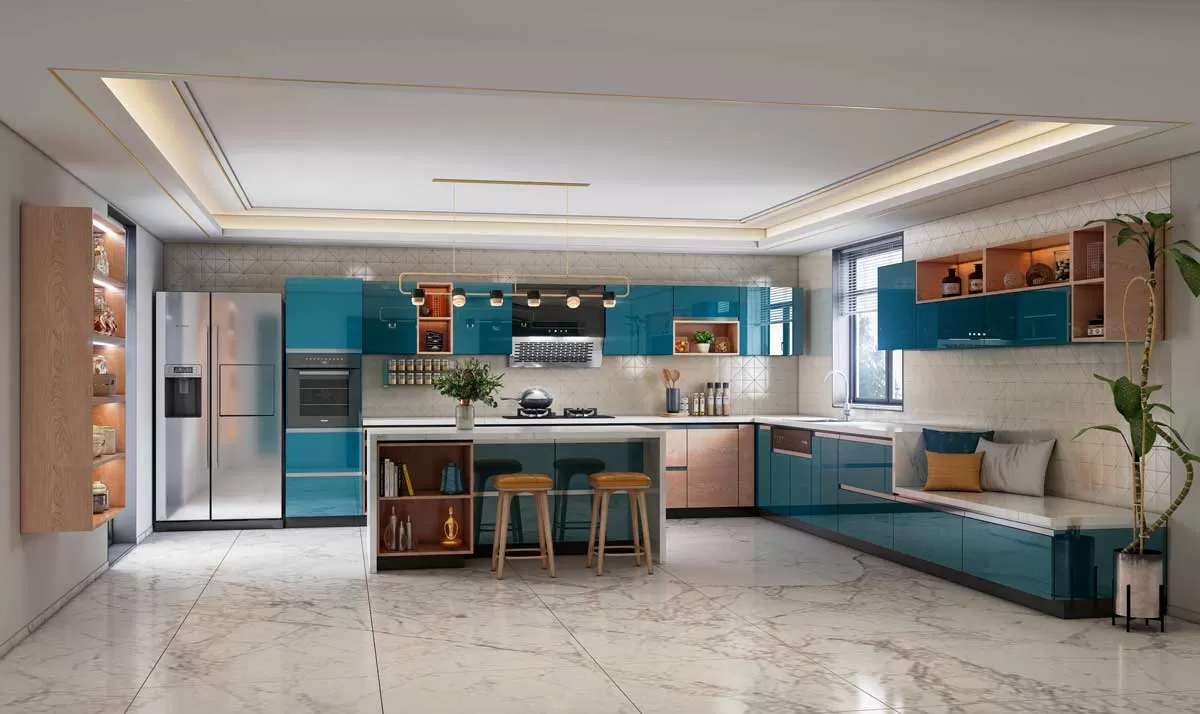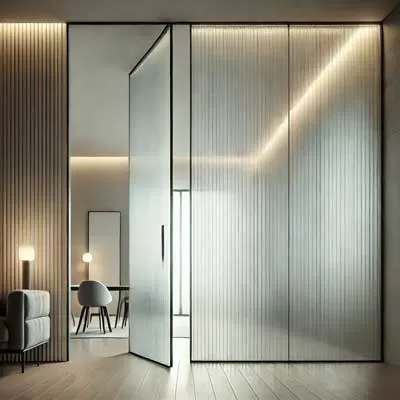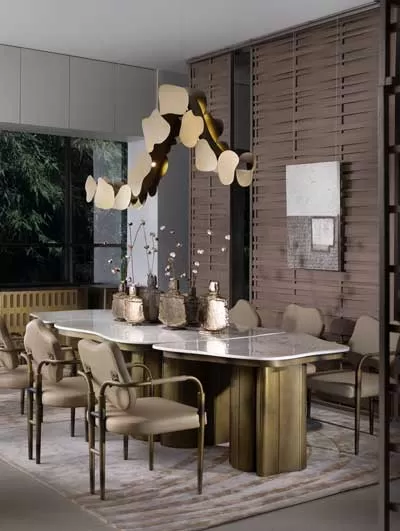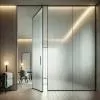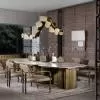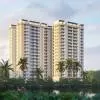The size of the Indian modular kitchen market is expected to reach $ 13.57 billion by 2029, growing at a CAGR of 24.36 per cent during the forecast period (2024-2029). The increase in income levels and rising demand for layouts that incorporate flexibility and agility and space-saving storage systems that use every nook and corner while keeping the aesthetics in mind adds to their lure. With consumers willing to experiment with designs, textures, myriad colour combinations and features such as magic corners and kitchen island concepts to add luxury touches to the cooking space, manufacturers are increasingly offering world-class products.
In addition, kitchen furniture in India is witnessing continuous growth with an increasing share of sales through online channels, providing buyers with discounts and lucrative offers that allow them to design kitchens according to their taste, requirement and budget. This trend is leading global majors to establish their stores and supply chain network in major Indian cities such as Delhi, Mumbai, Bengaluru and Ahmedabad, and foray into Tier 2 and Tier 3 cities.
Demand drivers in 2024
“Some drivers of the Indian modular kitchen market are increased awareness and emphasis on sustainable living; growing urbanisation and changing lifestyles; rising disposable income, demand for modern living spaces and the preference for modular solutions,” observes Saniya Kantawala, Principal Designer and Founder, Saniya Kantawala Design (SKD). About the ratio of the organised versus the unorganised market, Monika Choudhary, CDO,
Co-Founder and Growth Strategist, Habitat Architects, adds, “There is a disproportionately sizeable unorganised market. But as numbers show, interest in and knowledge of a modular kitchen's conveniences are rising steadily. With increased understanding among homeowners, many modular kitchen designers and agencies offer a convenient way of designing and installing custom solutions that are unique to each layout.”
Maximum market share
In 2024, the segment by product that gained the maximum market share is probably tall storage cabinets, driven by the need for efficient space utilisation in residential and commercial settings. “Online sales could be the distribution channel segment gaining the most, reflecting the growing e-commerce trend in the home improvement sector,” says Kantawala, commenting on which segment has gained maximum market share compared to 2023.
“We plan to leverage online sale of our kitchens through our E-com channel by selling preconfigured modules, designed to suit basic kitchen configurations,” says Vaishali Shah, Deputy General Manager, Design, Godrej Interio, when asked how the company is leveraging online sales. “Also, we plan on having the kitchen configurator up on the website that will help customers visualise their kitchen and browse through the plethora of options available.
To take this further, we intend to connect customers to the nearest dealer with the configured 3D model who can take up the
exact site specifics and give the
final solution as per the site
and civil demands.”
“While the kitchen layout is a primary driver of adding or removing cabinets, tall storage cabinets are general requirements in most of our designs,” says Choudhary. “Bespoke and customisable cabinets help us achieve the desired length, seamlessness, visual style and open or introverted kitchen layouts.”
Most popular layouts
“The L-shaped layout is the most popular choice for Indian kitchens due to its efficiency in utilising space and ability to facilitate a smooth workflow between the sink, cooktop and refrigerator,” says Kantawala about the most popular layout to maximise efficiency and optimise storage systems by using every nook and corner of the area.
Full or semi-modular?
“Fully modular kitchens offer a wide range of options for customisation, storage solutions and ease of installation; still, they may be more expensive and less flexible in terms of design changes,” she adds about the pros and cons of fully modular versus semi-modular in terms of options for cabinet styles, finishes, materials, accessories, ability to meet specific preferences, optimising space, providing clever storage solutions, saving time and money with faster installation, precision, durability, dismantling, changing, repairing and shipping to a new site. “Semi-modular kitchens balance customisation and affordability, offering options while allowing some flexibility and customisation.”
Modular kitchen installation
“Modular kitchen installation typically takes around two to four weeks, depending on the complexity of the design and customisation,” says Kantawala. “While we mostly use custom kitchens, our installation involves completely knocked down (CKD) units assembled onsite to ensure precision and customisation. Our latest installation advancements include prefabricated modules and modular assembly techniques which minimise installation time and maximise efficiency. Usually, offsite installation is easier, saves time and ensures quality control, leading to cost savings and greater efficiency.”
“If the kitchen site involves civil, electrical and plumbing changes, it may take 10-15 days to get the site ready for kitchen installation,” Shah weighs in. “All our kitchens are CKD and need installation on site. As they are designed for faster installation, the overall time is much lower than any fabricated kitchen made by carpenter or local players. We have only onsite installations, which have way more advantages than any offsite method.”
“An ideal solution is offsite manufacturing and assembly with onsite installation,” says Choudhary. “This practice works with maximum efficiency only when the dimensioning and documentation processes are executed with the most minuscule error margins. This system achieves simultaneous multitasking both on and off construction sites and demands the least onsite attention. In many cases where a seamless process cannot be accomplished, the onsite execution leaves the minimum margin for execution errors.”
Optimising the work triangle
The kitchen’s ‘Golden Triangle’ analogy, highlighting the importance of balancing form and function to create a functional and aesthetically pleasing space, focuses on keeping the refrigerator, sink and stove all within equal reach.
“Our products are meticulously designed to optimise the work triangle principle, ensuring a smooth workflow and efficient use of space between the sink, cooktop and refrigerator,” says Kantawala. “A basic rule of thumb for an efficient kitchen design is the rule of the kitchen triangle,” affirms Choudhary. “Any addition to this worked-out dynamic can be accommodated smoothly. The kitchen triangle principle states that cooktops and equipment zones must be one vertex of a triangle with the other two ends being the refrigerator with pantry and cleaning zones or outlets.”
“The work triangle is a function of two aspects,” elaborates Shah. “One is efficient planning of the kitchen. Second is the modular solutions that can be provided to cater to these three kitchen elements. So, spacing the sink and cooking area and having the electricals built in for the refrigerator are critical. That’s a function of planning when it comes to the second aspect, which is modularity. Apart from the right accessories, if your appliances are incompatible with the cabinetry, it becomes a mismatch. For cleaning purposes, the sink, water inlet, outlet and drains should be properly set up. After cleaning, to dispose residual garbage (peeled vegetables,
etc) we have different kinds of
pull out or door-mounted waste bins to suit different preferences and ways of working. Then apart from built-in refrigerators, as freezer storage has increased, people are choosing exclusive freezers for dry fruits, spices or ice cream. With
the right kind of planning, you
can create a very smooth, functioning kitchen.”
Storage and functionality
“Our kitchens feature innovative storage solutions such as pull-out shelves, corner units and drawers with dividers to maximise space and organisation,” says Kantawala. “Our soft-close drawers and integrated lighting enhance functionality and ease of use.”
Materials and durability
“Our cabinets, countertops and other components are crafted from durable materials such as engineered stone, steel and high-quality wood to ensure longevity and resistance to fire, moisture, heat and pests,” she adds.
Budgets and cost-saving strategies
“The estimated cost of our modular kitchens varies depending on factors such as materials, customisation options and design complexity,” says Kantawala. “To make our products more accessible to customers, we offer financing options, along with warranties on components and installation.”
The price range varies depending on cost of materials, customisation options, design and planning, installation method, brand, quality and location, cabinet configuration, and selection of appliances, countertops and sink taps. “We implement various cost-saving strategies, including soft-closing mechanisms for shutters to enhance durability and reduce wear and tear, natural materials that are locally sourced, durable and thus more viable in the long run and energy-efficient lighting solutions and fixtures to reduce long-term energy costs,” she adds.
For her part, Shah says, “We have options in accessories to suit different budgets and the core material of the cabinetry can be scaled up or down to suit budgets.”
Latest trends
“Open-plan layouts, blending kitchen and living areas, space-saving ideas, clever storage solutions and emphasis on design, textures and solid-coloured laminates to create visually appealing spaces are the latest trends that are dominating designs in 2024,” informs Kantawala.
“At Habitat, passing trends often seem short-lived,” according to Choudhary. “The standard operating model is to respond to site constraints for design and layout decisions.”
“In terms of layouting, people want open kitchens as typical Indian cooking involves a lot of tadka and tempering,” says Shah. An efficient extraction or hood can work well for open kitchens. For civil structures, with more users opting for a window in the kitchen, maybe the construction industry may shift to this trend. In bungalows, you have the family getting together, cooking together and sitting around the kitchen while having meals. In the finishes, in India high gloss still dominates. There is a particular acrylic material, in thinner as well as thicker formats, which satisfies both high gloss as well as matte options for shutters. Instead of glass, we now see a shift towards acrylic as it is not prone to damage and is easy to clean. So, people are looking for low maintenance, easy to clean materials and finishes for their fronts. For the space-saving trend, after COVID, there's a lot more hoarding of groceries and ready snacks in kitchens. Platform and wall storage units cannot satisfy this volume so we brought in a new range of tall units that increase the storage volume manifold to the tune of 5x at least and cabinets that go in deeper from the floor to the top.”
Global trends in Tier 2
and Tier 3 cities
“Metros and Tier 2/3 cities in India are increasingly adopting global trends such as smart kitchen technologies, innovative storage solutions and premium quality materials to enhance functionality and aesthetics of their kitchens,” shares Kantawala. “We incorporate European design elements to meet the evolving preferences of Indian households, offering sleek and contemporary designs that resonate with modern lifestyles.”
Automation and tech
“Our products incorporate technology such as home automation systems, embedded sensors and smart appliances to enhance functionality and convenience for users,” she adds. “We integrate unique lighting concepts and interactive features to create a modern and efficient kitchen environment.”
Lending a developer perspective, Saket Mohta, MD, Merlin Group, says, “We use home automation systems, embedded sensors, interactive features and integration with smart appliances and lighting concepts to create a wonderful experience for users. Through smart home technology and home automation systems, we aim to enhance the user experience and make everyday tasks more efficient. Smart home technology players are collaborating with the real-estate industry to develop innovative solutions to meet the needs of the Indian market.”
“Our company leverages augmented reality (AR) and virtual reality (VR) technologies to enhance the customer experience by offering visualisation and customisation of kitchen designs,” says Kantawala. “Customers can view 3-D renderings of proposed kitchen designs, allowing them to visualise the outcome and make informed decisions.”
“We've done virtual showrooms where people wearing VR lenses can walk in, see different kitchen formats with options to get an understanding of how a finish would look in a true scale,” shares Shah. “Now, we are going to bring out software with very high resolution where customers will get the opportunity to change the finish and check if it works for them in their space.”
Sustainability concerns
In India, many builders rely on age-old methods of constructing a kitchen slab first with traditional materials, leaving behind a substantial carbon footprint. But things are changing.
“We reduce carbon emissions in kitchen construction with the use of eco-friendly materials such as natural stone, recycled glass or reclaimed wood for countertops,” Mohta tells us. “Others use energy-efficient appliances that consume less electricity and gas such as induction cooktops and Energy Star-certified appliances.”
Modular, the way ahead
The way forward appears to
be modular.
In tiny apartments where space is always at a premium, modular kitchens maximise the use of every inch of space. Designed by experts, these factory-made kitchens are finished to perfection with neatly sealed edges and perfectly aligned shutters and drawers with provisions for appliances to be neatly tucked away when they are not being used.
“Manufacturers face challenges such as sourcing raw materials, supply chain disruptions and competition from the unorganised sector, which can impact production timelines and overall operational efficiency,” says Kantawala. But if you consider space optimisation, customised design solutions and technical evolution, an ordinary kitchen can never match the timeless appeal, efficiency and utility of a modular kitchen.
- R SRINIVASAN
